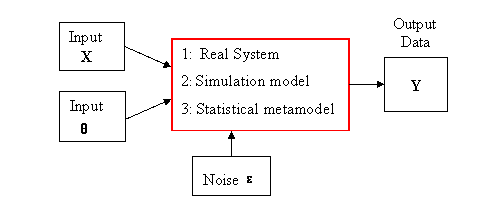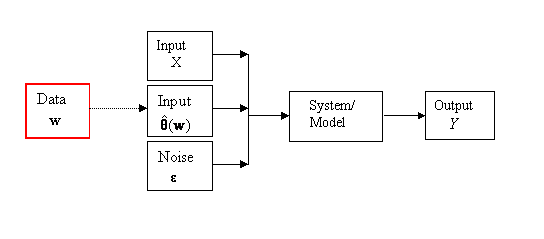Computer
Analysis of Data and Models
Part I
1. Introduction
This course aims to bring together modelling and statistical methodology in the way that it is actually used in practice. The course provides the student with the information and viewpoint that I have found most useful in tackling a modelling problem - the sort of things that in retrospect I wished had been pointed out to me when I first encountered problems of this sort.
Those near the end of an MSc programme in either Statistics or OR will already have encountered most of the methods used in this course. However these will usually have been taught somewhat in isolation, each within a formal, even disembodied, setting in which there is not enough scope, or time, to emphasize the overall way that these methods invariably come together when studying a modelling problem. There is a natural order in which the methods are used, giving them a power and unity that is often not well appreciated by a student.
This course aims to revisit statistical and modelling methodology in a way that emphasises how they are used in practice. It emphasises what should be going through the mind of the investigator at each stage, namely that an overall problem can be broken down into a standard set of subproblems all of which will invariably occur. The subproblems will be reviewed and discussed, in a unified way in this course.
By the end of the course the student should be much more assured in the way that she/he confronts and tackles such a modelling exercise. There will be a much better awareness of the steps needed to carry out an exercise successfully, and of the problems and issues that occur at each step.
A very good book that has a similar philosophy to this course is An Introduction to Statistical Modelling by W.J. Krzanowski, (1998) Arnold, London. However this reference has a stronger statistical emphasis than we adopt and gives rather less attention to the resampling methods that we shall be using in the analysis.
Resampling is
quite well covered in the book Computer Intensive Statistical Methods by J.S.U.
Hjorth (1994) Chapman & Hall,
2. Statistical MetaModels.
This course emphasizes the importance of
statistical metamodels for analysing
data. We need therefore to be clear what is meant by a metamodel and this is
discussed first.
Figure 1 illustrates the situation where we
have data, Y (here and throughout this text, a quantity is
written in bold to indicate that it is a vector quantity), available concerning
the behaviour.of a system under study. The system itself, represented by the
box in the middle, might be simple but it will typically be complicated or even
unknown. We call Y the output
and this is what we wish to analyse, to learn about the behaviour of the
system.
We also have input quantities, whose values are expected to influence the
output. The inputs are divided into two types. The input X = (X1, X2, … , Xk)
is a vector of k explanatory
variables. These are known quantities and indeed may possibly be under the
control of the investigator. The input θ = (θ1, θ2,
…, θp) is a vector of
parameters which influence the output but whose values are not controllable.
Often they will be unknown. Their values would therefore have to be estimated.
In addition the output Y may contain a
random component, typically referred to as ‘noise’ or ‘error’. This is denoted
by ε.
Figure 1: Schematic of the System

As well as depicting the situation where the
output data has been obtained from a real system Figure 1 also illustrates the
situation where we have constructed a simulation model and have made simulation
runs with it to obtain simulated output data. This is indicated in Figure 1 by
replacing the real system in the central block by a simulation model. All other
blocks remain the same.
In this course the focus is on how to analyse
Y and in particular to identify how the inputs X and ![]() influence Y in the presence of the random effects
influence Y in the presence of the random effects
![]() . We use a statistical
model for doing this. We shall make precise later what is meant by a
statistical model. However we observe here that the structure of the process is
unchanged, and this is emphasized by using Figure 1 yet again, only with the
central block now representing the statistical model.
. We use a statistical
model for doing this. We shall make precise later what is meant by a
statistical model. However we observe here that the structure of the process is
unchanged, and this is emphasized by using Figure 1 yet again, only with the
central block now representing the statistical model.
The term
statistical model is conventionally used when we are analysing data obtained
from a real system. In the case of data obtained from a simulation model, then
the statistical model is a model of a model, so to speak – and this is when the
term metamodel is used. It will be
clear that whatever statistical model is deemed appropriate in a given
situation is determined purely by the structure of the data and not by its
origin. Thus the model would apply whether the output came from a real system
or a simulation model.
Example 1: Consider the operation of a queue
where we are interested in estimating, the average queue length, over a given
period of time, T say. Here Y might be the sampled mean queue length
over a period of length T. Input
quantities are λ the arrival
rate, and μ, the service rate,
and C might be the number of servers
available. Traffic Queue Length EG
![]()
This is a situation that has been well
analysed theoretically and where the relationship between Y and the quantities λ,
μ and C is known precisely in certain situations. However we might be
uncertain about the precise form of inter-arrival and service time
distributions. We can assume that the results of n simulation runs take the form
![]()
![]() (1)
(1)
where ![]() is some suitably
selected function characterising the likely behaviour of Y. The quantity
is some suitably
selected function characterising the likely behaviour of Y. The quantity ![]() is a random variable.
A common assumption is that the errors have a normal distribution:
is a random variable.
A common assumption is that the errors have a normal distribution:
![]() ~
~ ![]() . (2)
. (2)
This assumption is questionable in the
present context as the variability of Y
will depend critically on the traffic intensity ![]() , so the assumption of constant variance
, so the assumption of constant variance ![]() for the observations Y is dubious. □
for the observations Y is dubious. □
Example 2: The National Health Service has
data for, Y, the number of newly
registered diabetics in each year for a given number of years. It also has data
on a selection of factors that might influence the onset of diabetes such as, X1 amount of alcohol
consumed; X2 the number of cigarettes smoked, per
day; X3; previous illnesses contracted, age, sex of each case. The
problem here is to those identify factors that have a significant influence on
the onset of diabetes. A typical model is
![]() . (3)
. (3)
where yi
is the observed number of registered diabetics in year i and xij is the observed value of the jth factor in year i; and
we have n years of observations.
Again we might assume normal errors ![]() ~
~ ![]() . □
. □
The scenario of Figure 1 can be varied or
extended in many different ways. We illustrate this with two commonly occurring
situations.
The first is illustrated in Figure 2. This is
the situation where the input θ parameters can be estimated using data or past
information, w, containing information about θ. Sometimes
this information is not explicit but is derived from expert opinion. The
estimation in this latter case is then possibly subjective. We write these
estimates as ![]() , or simply as
, or simply as ![]() depending on whether
past data w is involved or not, using the circumflex to indicate an
estimated quantity.
depending on whether
past data w is involved or not, using the circumflex to indicate an
estimated quantity.
Figure 2: Input Parameters Estimated from
Data

Example 1
(continued): It
may be that λ, the arrival rate,
is not known. However we have a sample of interarrival times from which λ can be estimated. □
Another important variation is when a dynamic
system or simulation is being examined. Here time - which we denote by t
- enters into the picture. It is usually best to treat t as being a continuously varying input variable that is part of
the input X, but which then results in the output Y being time-dependent. Figure 3 represents this time dependent
situation.
Figure 3: Schematic of a Dynamic System/Model
Data
w System/ Model Output Noise
ε Input Input X![]()
![]()
![]()
![]()
![]()
![]()
![]()
![]()
![]()
![]()
![]()


Example 3: In the study of an epidemic let η(t, θ) represent the prevalence of a certain disease at
time t. (Prevalence means the
proportion of the population who has the given disease.) Several scenarios are
possible. Firstly, it may be that there is no information on θ, but
there are observations yi
of the prevalence at given time points ti
i =1, 2, ..., n. These are subject to error, thus
yi = η(ti, θ)
+ εi, i
=1, 2, ..., n. (4)
Then the problem would be to fit θ to
the observations {yi}.
Secondly we might have past information w on which θ depends
and the task is then to estimate θ from the information w. The
third possibility is when we have both observations {yi} of the epidemic and there is past information w on
the parameters θ. In this case we should use both the {yi} and w to estimate θ.
The following is a set of data giving the
number of notifications of pulmonary TB (per 100,000) in
In dynamic problems the regression
formulation (4) is typical. The regression function η(t, θ)
has to be selected so that its behaviour resembles the output of the system or
mathematical/simulation model that it represents. In some situations, as might
occur in the dynamic case just considered, the physical process of the actual
system may be sufficiently known to suggest a natural form for η(t, θ).
Example 4: The logistical curve
![]() (5)
(5)
is commonly used to represent population
growth when this takes a sigmoidal form. □
Exercise 1: Plot the logistic curve on a
spreadsheet for different combinations of α,
β, γ. □
If little is known about the real system, the
form assumed for η(t, θ) does not have to be
complicated. When there is a single explanatory variable X then a low polynomial function of X is a typically used model:
![]() (6)
(6)
When there are a large number of factors, and
especially when the errors ε are not small then a multivariate
linear form is often used:
![]() (3
bis)
(3
bis)
Here the xi
are the values of the different factors, and the model only considers the
inclusion of a linear term for each factor.
Example 2 is an illustration of a situation where this multivariate form
is appropriate.
Sometimes the output Y takes a binary form, indicating success (Y = 1) or failure (Y =
0). Representing Y in terms of a
continuous function is not then very sensible. The usual ploy is to model the
probability π that Y = 1 and then to ensure that π lies between 0 and 1 by using a
transformation such as the logistic transformation. This is usually written as
![]() (7)
(7)
but the more correct version is
![]() (7a)
(7a)
as (in the one x variable case) it is actually
![]() (7b)
(7b)
that is the logistic transform.
This binary model is best not thought of in
regression terms. Instead we regard each observation as a Bernoulli variable
Yi ~ Bernoulli(![]() ) (8)
) (8)
Example 4½: An example of binary response
data: Vaso Constriction Data
As far as this course is concerned we will be
focusing on the third representation of Figure 1 where we use a statistical model to describe the
output. The first step in model formulation is therefore to write down the
distributional form of the output and in particular to make explicit how the
distribution is expected to depend on the input quantities. It should be
stressed that the statistical model does not have to precisely copy the
characteristics of the underlying true model, which anyway may be too
complicated to be sensibly reproducible. Rather the statistical model has to be
capable of modelling the essential features of the system it represents, but
that is all that is needed. Figure 4 illustrates this key requirement, in the
dynamic case, by including boxes to represent both the unknown system and the
statistical model representing it. The parameters ![]() of the statistical model do not have to correspond
in any explicit way to the parameters θ of the system, and this is
indicated in Figure 4
of the statistical model do not have to correspond
in any explicit way to the parameters θ of the system, and this is
indicated in Figure 4
Figure 4: This depicts a Statistical Model of
a System.
It also depicts a Metamodel of a Simulation
Model
Output Output Input
X System/
Model Input Data
w Noise
U Statistical Model..
![]()
![]()

![]()
![]()
![]()
![]()
![]()
![]()
![]()
![]()
![]()
![]()
![]()
![]()
![]()
![]()

Often the regression format is a convenient
one to use. However, as the last example shows, the regression approach is not
completely general. In fact the procedure used in equation (8) of the last
example, of treating Y as a random
variable and writing down its distribution
by name, is a very good one to
follow. The distribution will usually depend on parameters. It is also
necessary therefore to write down how these parameters of the distribution
depend on the input variables and on the input parameters of the process model.
This first step of treating the output Y as a
random variable and of identifying its distribution is essential in determining
the most appropriate subsequent analysis.
We discuss the main characteristics of random
variables in the next Section in Part II.